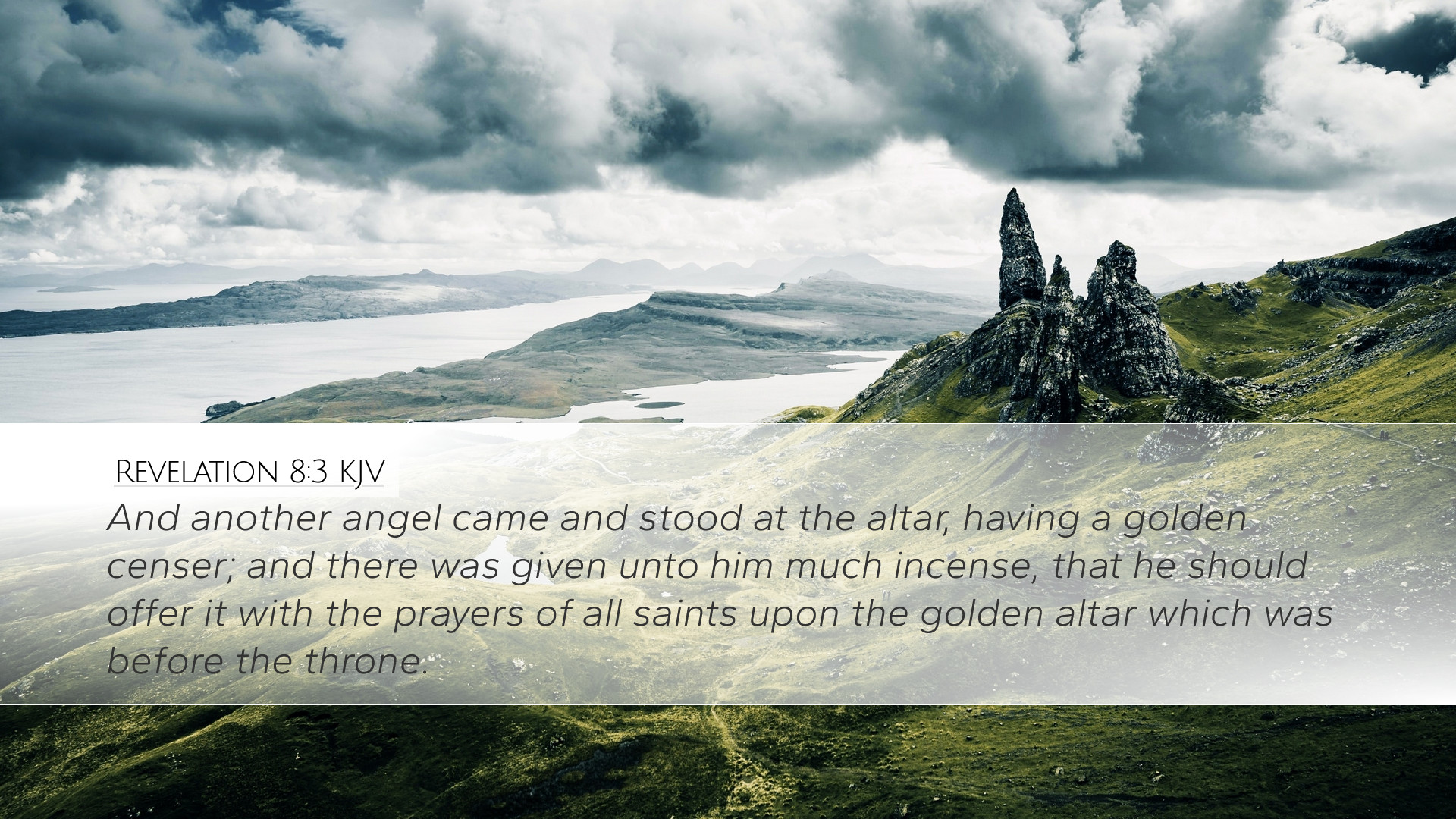Commentary on Revelation 8:3
Introduction:
The verse Revelation 8:3 presents a profound moment in the heavenly narrative, depicting the function of prayer and the solemnity of divine judgment. It states:
"And another angel came and stood at the altar, having a golden censer; and there was given unto him much incense, that he should offer it with the prayers of all saints upon the golden altar which was before the throne."
Contextual Background
This verse falls within the larger context of the opening of the seventh seal and the ensuing trumpet judgments. The heavenly scene marks a transition from the seals to the trumpets, signifying an intensification of divine activity.
Insights from Matthew Henry:
Matthew Henry emphasizes the significance of prayer in this verse. He points out that the angel, representing a mediator, performs the act of offering incense, which symbolizes the prayers of the saints. Henry notes that:
- The Golden Censer: The golden censer is a powerful symbol of the purity and preciousness of the prayers lifted up to God. It signifies the divine approval of these petitions.
- The Altar: The altar's location, before the throne of God, underscores the immediacy and accessibility of divine grace. It indicates that the prayers of the saints are always in the presence of God.
- Unity of Believers: Henry suggests that this passage showcases the unity of the church and its collective prayers. It reflects the idea that individual prayers, when combined, create a powerful plea before the Throne of Grace.
Insights from Albert Barnes:
Albert Barnes provides a detailed exposition of the imagery used in this passage. He illuminates the following aspects:
- The Role of the Angel: Barnes describes the angel's act as a vital ministry, involving both sacrifice and intercession. The angel's use of incense indicates its role in purifying these prayers and making them acceptable before God.
- Much Incense Given: The phrase "much incense" suggests the abundance of grace and mercy available to the faithful. It signifies that the prayers ascend with great efficacy and intensity, pleasing unto God.
- Symbolism of Incense: Incense is historically representative of prayer throughout Scripture. Barnes notes that in old testament practices, incense equated to the sweet aroma associated with worship and sacrifice.
Insights from Adam Clarke:
Adam Clarke offers a theological reflection on the concept of intercession depicted in Revelation 8:3. His commentary includes:
- Intercessory Role: Clarke elaborates on the role of the angel as a figure of intercession between God and humanity, stressing the importance of this mediation in the spiritual realm.
- The Connection of Prayers: He emphasizes that the prayers of the saints are not simply expressed; they are intricately woven into the fabric of divine purpose and preordained plans, suggesting a cosmic significance to every supplication.
- The Altar of Incense: Clarke draws parallels between this heavenly altar and the earthly tabernacle's altar of incense, indicating that this very act holds a timeless aspect of worship that transcends both covenants.
Theological Themes:
The broader theological implications of Revelation 8:3 encompass several critical themes:
- Prayer and Divine Relationship: The offering of prayers serves as a reminder of the intimate relationship between God and His people, showcasing that the Almighty is attentive to their cries and petitions.
- Intercession of Christ: The imagery of the angel further reflects the role of Christ as the ultimate intercessor, as highlighted in Hebrews, reinforcing that prayer is managed through His righteousness.
- Judgment and Mercy: This passage juxtaposes the aspects of divine judgment (ushered in by the trumpets) with God’s mercy (extended through prayer), illustrating a balanced view of God’s character.
Practical Applications:
For pastors, students, and theologians, several practical applications emerge from Revelation 8:3:
- The Power of Collective Prayer: Engage congregations in understanding and practicing the power of communal prayer, reminding them of its essential role in spiritual warfare and divine intervention.
- Encouraging Persistence: Encourage the saints to remain steadfast in prayer, as highlighted by the representation of their petitions in the heavenly realm, which God honors.
- Teaching About Mediation: Educate believers about the importance of Christ's mediating role and how it assures them that their prayers reach God, bolstering their faith in uncertain times.
- Understanding God’s Nature: Promote theological discussions around the duality of God's nature - the just judge and the merciful father - urging a balanced approach to the character of God in their teaching and preaching.
Conclusion:
In summary, Revelation 8:3 serves as a vitally rich text for understanding the intersection of divine intercession, the prayers of believers, and the atmosphere of heavenly worship. Through the insights gleaned from public domain commentators such as Matthew Henry, Albert Barnes, and Adam Clarke, we discern a multi-faceted tapestry of theological significance. This passage not only provides knowledge for academic study but offers practical wisdom for the faith community, evoking a deeper engagement with prayer and the divine attributes of mercy and justice.


